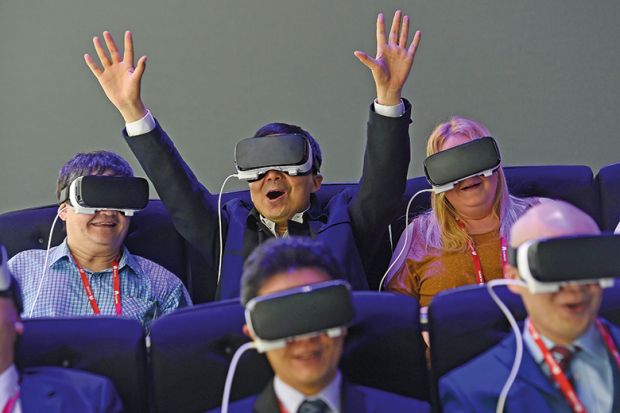Teaching students face-to-face peaked as a matter of importance “at some point around 1985” with the introduction of what are now called PowerPoint presentations into the classroom, one edtech expert has claimed.
“It has been downhill ever since – in the future, everything will either be hybrid or online only,” Phil Regier, university dean for educational initiatives at Arizona State University, told a symposium on technology-dependent learning at King’s College London on 24 April.
Here, technology experts explain which innovations are most likely to transform higher education and which ones will struggle to make an impact.
Augmented reality
Forget the clunky and expensive headsets of virtual reality, augmented reality (AR) is the next big thing in university teaching, many experts believe.
Once limited to Hollywood films (think Tom Cruise’s Google Glass-style sunglasses in the Mission Impossible franchise), AR may soon be fairly widespread in the education world.
Some students supported by Jisc, the UK higher education sector’s technology champion, are already working on an app that would allow a visitor to campus to point their smartphone at an object and gain multilingual content, photos or video footage of related events, as well as interviews with staff and students – potentially transforming the university open day.
In the teaching world, AR has the potential to transform the teaching of subjects such as engineering, Alex Mackman, technical director at Agylia, which creates app-based training products, told the King’s conference.
“Imagine if you could look at a complex piece of equipment and information was then overlaid [on] that image,” he explained, suggesting AR’s ability to disrupt current norms of training. He added: “Many of our engineering clients are getting quite excited about AR.”
Virtual reality
Despite the lukewarm reaction from the public over the years, don’t write off virtual reality (VR).
In January, Facebook founder Mark Zuckerberg confirmed that he will spend about $3 billion (£2.3 billion) over the next five to 10 years on VR, suggesting that many in the tech world still see its huge potential.
Last year, a Goldman Sachs report predicted that there could be a $700 million, 15 million-user market in schools and universities by 2025, although the price of headsets (often about $3,000) is proving a major sticking point for those keen to adopt the technology.
Tim Drewitt, product innovator at software developer Kallidus, said that only 15 per cent of its clients were actively considering using VR for training over the next few years.
If the price of headsets falls – Mr Zuckerberg predicts affordable sunglasses-style goggles are the future – universities’ use of VR may well take off.
Gamification
Millennials – those born between the early 1980s and early 2000s – are consuming content in an entirely different way to older generations, explained Joshua Roberts, owner of e-learning company Gaming in Training.
“About 75 per cent are watching television with a second screen in their hand,” he added of the vogue to tweet along about everything from Question Time to the latest Premier League match.
“This is how gamification came around,” he told the audience at King’s.
Educational training is now moving away from a system of accumulating points or qualification badges to one in which various psychological hooks, used by video games to keep players' attention, are introduced into the classroom, Mr Roberts said. He argued that visible leader boards that introduce healthy competition among students, and Candy Crush-style duels, can push learners to achieve more.
Lecturers may already use some of these tactics but experts predict that more high-tech versions will become commonplace.
Game-based learning
Different to gamification, this method sees educators use video games as tools to teach certain topics.
Many academics are already using Minecraft, in which users create virtual worlds, to teach architecture, civil engineering and other technical subjects, while even the long-forgotten platform Second Life has a surprisingly large number of users in universities.
Creating bespoke versions of video games for undergraduate learning may, however, prove the biggest barrier to making game-based learning more popular in universities, said Mr Roberts.
“Game-based learning is a much higher-cost proposition for clients [than gamification],” he said, explaining that potential investors often struggle to see exactly how a computer game will meet their specific educational or training needs, particularly given the high cost of creating one.
Professional online networks
They may lack the “wow” factor attached to more futuristic types of edtech, but professional online networks, such as LinkedIn, could be just as important.
In industry-facing subjects, lecturers tend to know their profession far better than most university careers advisers, so working with students on their LinkedIn profiles for the duration of their degree could soon become a key part of what academics do. Some universities are even helping students to set up a LinkedIn page during freshers’ week, introducing the idea that this task is not simply something to do in the final weeks before graduation.
“There are no silver bullets around education in terms of technology,” said Professor Regier, who is also chief executive officer at EdPlus, Arizona State’s e-learning initiative.
“However, at the core of all [of these technologies] you will still need a teacher in the middle of everything making things more effective."
Register to continue
Why register?
- Registration is free and only takes a moment
- Once registered, you can read 3 articles a month
- Sign up for our newsletter
Subscribe
Or subscribe for unlimited access to:
- Unlimited access to news, views, insights & reviews
- Digital editions
- Digital access to THE’s university and college rankings analysis
Already registered or a current subscriber? Login








